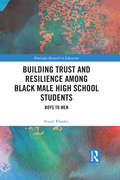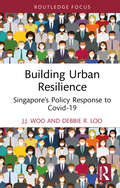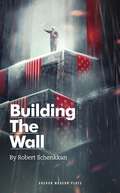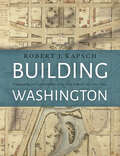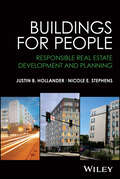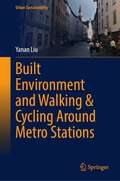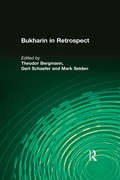- Table View
- List View
Building Trust and Resilience among Black Male High School Students: Boys to Men (Routledge Research in Education #26)
by Stuart RhodenCentered on a case study of a mid-Atlantic charter school, this book identifies the key factors that help Black male students navigate high school in spite of traditional and historical barriers. Rather than examining their experiences through a deficit model, this book adds to the growing body of data on the importance of positive role models—including parents, peers, teachers, and administrators—in facilitating socio-emotional and academic success at the secondary and postsecondary level. Rhoden demonstrates that encouraging trust and persistence in Black male students are essential components to positive academic and social achievement in the face of perceived and real structural inequalities.
Building Trust and Resilience among Black Male High School Students: Boys to Men (Routledge Research in Education #26)
by Stuart RhodenCentered on a case study of a mid-Atlantic charter school, this book identifies the key factors that help Black male students navigate high school in spite of traditional and historical barriers. Rather than examining their experiences through a deficit model, this book adds to the growing body of data on the importance of positive role models—including parents, peers, teachers, and administrators—in facilitating socio-emotional and academic success at the secondary and postsecondary level. Rhoden demonstrates that encouraging trust and persistence in Black male students are essential components to positive academic and social achievement in the face of perceived and real structural inequalities.
Building Trust in the International Monetary System: The Different Cases of Commodity Money and Fiat Money (Frontiers in Economic History)
by Giovanni Battista Pittaluga Elena SeghezzaThis book presents the evolution of the international monetary system from the gold standard to the monetary system in force today. It adopts a political economy approach, emphasizing the economic and political conditions under which an international monetary system can come into existence and be maintained over time. This approach highlights how the gradual transition in the international context from commodity money to fiat money has been led by the need for greater elasticity of money supply and smooth adjustments. This transition, however, raises the issue of how to guarantee, over time, the value of a money devoid of intrinsic value. By presenting a historical evolution, the book explains how the existence of an international monetary system based on money without intrinsic value can only occur when a particular balance of power exists at the international level that allows for the production of trust in a fiat money. The book is a must-read for scholars, researchers, and students in the fields of economic history and international monetary economics, interested in better understanding the evolution of the international monetary system.
Building Urban Resilience: Singapore’s Policy Response to Covid-19 (Routledge Research in Sustainable Planning and Development in Asia)
by J.J. Woo Debbie R. LooThis is one of the first few books to discuss the Covid-19 crisis as an urban phenomenon and illustrates this through the case of Singapore and its pandemic response efforts.The book describes the implications and impacts of the pandemic on Singapore’s urban landscape, economy, and society. It also assesses the urban interventions that have emerged in response to the pandemic. It examines the spatial implications and challenges of delineating safe distancing in various public and commercial spaces and evaluates the effectiveness of these interventions. The book also explains how Singapore’s smart city capabilities help with its Covid-19 response.This book will be of great interest to urban planners, healthcare professionals, and policymakers across the world, particularly those who are hoping to learn from the success and limitations of Singapore’s Covid-19 responses.
Building Urban Resilience: Singapore’s Policy Response to Covid-19 (Routledge Research in Sustainable Planning and Development in Asia)
by J.J. Woo Debbie R. LooThis is one of the first few books to discuss the Covid-19 crisis as an urban phenomenon and illustrates this through the case of Singapore and its pandemic response efforts.The book describes the implications and impacts of the pandemic on Singapore’s urban landscape, economy, and society. It also assesses the urban interventions that have emerged in response to the pandemic. It examines the spatial implications and challenges of delineating safe distancing in various public and commercial spaces and evaluates the effectiveness of these interventions. The book also explains how Singapore’s smart city capabilities help with its Covid-19 response.This book will be of great interest to urban planners, healthcare professionals, and policymakers across the world, particularly those who are hoping to learn from the success and limitations of Singapore’s Covid-19 responses.
Building The Wall: The Play And Commentary With Afterwords By Timothy Mccarthy, Douglas S. Massey, And Julian E. Zelier (Oberon Modern Plays)
by Robert SchenkkanAmerica, 2019. A President impeached. In a world of ‘fake news’, can anyone admit the truth? 2019, America. Rick is incarcerated awaiting sentencing for the crime of the century. He grants just one interview – to Gloria, an African American historian. In a world of ‘fake news’ surrounding one of the world’s most powerful and controversial political figures, Gloria is Rick’s only chance to tell his version of the truth. Building The Wall examines what happens when an ordinary person becomes a cog in a regime and how the inconceivable becomes the inevitable. The UK premiere of this cutting and timely new drama is as hot as the US political debate that fills our news feeds. Don’t miss this gripping political thriller from Robert Schenkkan, a Pulitzer Prize and Tony Award-winning playwright and Academy Award nominee (Hacksaw Ridge).
Building Walls and Dissolving Borders: The Challenges of Alterity, Community and Securitizing Space
by Max O. Stephenson Laura ZanottiWalls play multiple social, political, economic and cultural roles and are linked to the fundamental question of how human beings live together. Globalization and urbanization have created high population density, rapid migration, growing poverty, income inequality and frequent discontent and conflict among heterogeneous populations. The writers in this volume explore how walls are changing in this era, when social containers have become porous, proximity has been redefined, circulation has intensified and the state as a way of organizing political life is being questioned. The authors analyze how walls articulate with other social boundaries to address feelings of vulnerability and anxiety and how they embody governmental processes, public and social contestation, fears and notions of identity and alterity. This book’s authors explore walls as the consequence of a changing web of social relationships. Whether walls are physical objects on the landscape or metaphors for difference among specific groups or communities, the writers consider them as heterotopias, powerful sites around which ways of living together are contested and transformed. They also investigate how architectural planning concerning walls may de facto become a means of waging war, as well as how demolishing walls may give way to new ways of imagining security.
Building Walls and Dissolving Borders: The Challenges of Alterity, Community and Securitizing Space
by Max Stephenson Laura ZanottiWalls play multiple social, political, economic and cultural roles and are linked to the fundamental question of how human beings live together. Globalization and urbanization have created high population density, rapid migration, growing poverty, income inequality and frequent discontent and conflict among heterogeneous populations. The writers in this volume explore how walls are changing in this era, when social containers have become porous, proximity has been redefined, circulation has intensified and the state as a way of organizing political life is being questioned. The authors analyze how walls articulate with other social boundaries to address feelings of vulnerability and anxiety and how they embody governmental processes, public and social contestation, fears and notions of identity and alterity. This book’s authors explore walls as the consequence of a changing web of social relationships. Whether walls are physical objects on the landscape or metaphors for difference among specific groups or communities, the writers consider them as heterotopias, powerful sites around which ways of living together are contested and transformed. They also investigate how architectural planning concerning walls may de facto become a means of waging war, as well as how demolishing walls may give way to new ways of imagining security.
Building Washington: Engineering and Construction of the New Federal City, 1790-1840
by Robert J. KapschIn 1790, George Washington and Thomas Jefferson set out to build a new capital for the United States of America in just ten years. The area they selected on the banks of the Potomac River, a spot halfway between the northern and southern states, had few resources or inhabitants. Almost everything needed to build the federal city would have to be brought in, including materials, skilled workers, architects, and engineers. It was a daunting task, and these American Founding Fathers intended to do it without congressional appropriation.Robert J. Kapsch;€™s beautifully illustrated book chronicles the early planning and construction of our nation;€™s capital. It shows how Washington, DC, was meant to be not only a government center but a great commercial hub for the receipt and transshipment of goods arriving through the Potomac Canal, then under construction. Picturesque plans would not be enough; the endeavor would require extensive engineering and the work of skilled builders. By studying an extensive library of original documents;¢;‚¬;€?from cost estimates to worker time logs to layout plans;¢;‚¬;€?Kapsch has assembled a detailed account of the hurdles that complicated this massive project. While there have been many books on the architecture and planning of this iconic city, Building Washington explains the engineering and construction behind it.
Building Washington: Engineering and Construction of the New Federal City, 1790-1840
by Robert J. KapschIn 1790, George Washington and Thomas Jefferson set out to build a new capital for the United States of America in just ten years. The area they selected on the banks of the Potomac River, a spot halfway between the northern and southern states, had few resources or inhabitants. Almost everything needed to build the federal city would have to be brought in, including materials, skilled workers, architects, and engineers. It was a daunting task, and these American Founding Fathers intended to do it without congressional appropriation.Robert J. Kapsch;€™s beautifully illustrated book chronicles the early planning and construction of our nation;€™s capital. It shows how Washington, DC, was meant to be not only a government center but a great commercial hub for the receipt and transshipment of goods arriving through the Potomac Canal, then under construction. Picturesque plans would not be enough; the endeavor would require extensive engineering and the work of skilled builders. By studying an extensive library of original documents;¢;‚¬;€?from cost estimates to worker time logs to layout plans;¢;‚¬;€?Kapsch has assembled a detailed account of the hurdles that complicated this massive project. While there have been many books on the architecture and planning of this iconic city, Building Washington explains the engineering and construction behind it.
Buildings for People: Responsible Real Estate Development and Planning
by Justin B. Hollander Nicole E. StephensBUILDINGS FOR PEOPLE Buildings for People: Responsible Real Estate Development and Planning explores how to balance social concerns with financial and investment considerations without sacrificing profit. This timely volume provides key technical and practical knowledge while exploring real estate development and planning through a multi-level lens—revealing the systemic factors that both govern and are governed by the real estate process. Beginning with site selection, the authors discuss financing, site improvement, architecture, landscape architecture, site planning, construction, and evaluation within a broader political, economic, and social context. Throughout the text, the authors explain key theories and methods of professional practice, and highlight how important social issues are interconnected to the business of real estate development and planning. Demonstrating how the desire for profit can be balanced with the needs of society Buildings for People: Responsible Real Estate Development and Planning is an excellent textbook for advanced undergraduate and graduate students in real estate, urban planning, urban design, and urban studies courses, as well as a valuable resource for researchers and professionals who want a multidisciplinary understanding of the built environment.
Buildings for People: Responsible Real Estate Development and Planning
by Justin B. Hollander Nicole E. StephensBUILDINGS FOR PEOPLE Buildings for People: Responsible Real Estate Development and Planning explores how to balance social concerns with financial and investment considerations without sacrificing profit. This timely volume provides key technical and practical knowledge while exploring real estate development and planning through a multi-level lens—revealing the systemic factors that both govern and are governed by the real estate process. Beginning with site selection, the authors discuss financing, site improvement, architecture, landscape architecture, site planning, construction, and evaluation within a broader political, economic, and social context. Throughout the text, the authors explain key theories and methods of professional practice, and highlight how important social issues are interconnected to the business of real estate development and planning. Demonstrating how the desire for profit can be balanced with the needs of society Buildings for People: Responsible Real Estate Development and Planning is an excellent textbook for advanced undergraduate and graduate students in real estate, urban planning, urban design, and urban studies courses, as well as a valuable resource for researchers and professionals who want a multidisciplinary understanding of the built environment.
Built Environment and Walking & Cycling Around Metro Stations (Urban Sustainability)
by Yanan LiuThis book explores the relationship between pedestrians/cyclists’ mode and route choice to/from metro/railway stations and the micro-level (street-scale) built environment in a second-tier city in China. More specifically, it investigates how the street-scale built environment influences pedestrians/cyclists’ mode choice and route choice behavior and examines user preferences for the micro-level built environment around metro stations. The focus on a second-tier city is motivated primarily to expand the set of Chinese cities where the effects of the built environment on pedestrian/cyclist mode and route choice have been studied. Results demonstrate the effects of the street-scale built environment on pedestrian flows. The effects are higher for the main road, which is directly connected with the metro station. The findings of this book are expected to support the design of preferred walking/biking built environments around a metro station. This book appeals to urbanists, planners, engineers, policy makers, and those interested in a wide-ranging overview of slow/green transportation and built environment promotion. These methods not only help to understand the quantitative relationship between built environment design and travel behavior but also support the evaluation and assessment of built environment design in urban planning projects. It reduces the gap in our understanding of the quantitative relationship between the micro-level built environment and pedestrians/cyclists’ transportation mode and route choice around the metro station. Both stated choice data and revealed choice data were used. An extended set of micro-level built environment attributes was developed. Besides the widely studied transportation-related factors, street-level built environment factors were studied using quantitative methods.
Built on a Lie: The Rise and Fall of Neil Woodford and the Fate of Middle England’s Money
by Owen WalkerHe was the most celebrated and successful British investor of his generation - but it was all built on a lie. Neil Woodford spent years beating the market; betting against the dot com bubble and the banks before the financial crash in 2008, making blockbuster returns for investors and earning himself a reputation of 'the man who made Middle England rich'.But, in 2019, Woodford's asset management company collapsed, trapping hundreds of thousands of rainy-day savers in his flagship fund and hanging £3.6 billion in the balance.In Built on a Lie, Financial Times reporter Owen Walker reveals the disastrous failings of Woodford, the greed at the heart of his operation and the full, jaw-dropping story of Europe's biggest investment scandal in a decade.'Vital financial journalism with heart' Emma Barnett, broadcaster'This is a must read!' Vince Cable, former leader of the Liberal Democrats'Reads like a rip roaring tale of a corporate high wire act' John McDonnell, former Shadow Chancellor'Should be sold with a bottle of blood-pressure pills' Edward Lucas, The Time
Built Up: An Historical Perspective on the Contemporary Principles and Practices of Real Estate Development
by Patrice DerringtonBuilt Up uncovers the roots of the global real estate industry in the machinations of a patron of Shakespeare, the merged lineages of business savvy women and men, startlingly innovative collaborations with the first English architect, and the radical explorations of other denizens of early modern London – and what those colorful origins mean for the practice of property development today. Uniting insights from the author’s career as an internationally recognized developer with meticulous archival research, this resource for scholars and professionals synthesizes economic history and the latest planning and finance literature. The result is an unprecedented effort to codify the principles and activities of real estate development as a foundation for future academic research and practical innovation. By tracing the evolution of property development to its earliest days, Built Up establishes the theoretical groundwork for the next phase in the transformation of the urban environment.
Built Up: An Historical Perspective on the Contemporary Principles and Practices of Real Estate Development
by Patrice DerringtonBuilt Up uncovers the roots of the global real estate industry in the machinations of a patron of Shakespeare, the merged lineages of business savvy women and men, startlingly innovative collaborations with the first English architect, and the radical explorations of other denizens of early modern London – and what those colorful origins mean for the practice of property development today. Uniting insights from the author’s career as an internationally recognized developer with meticulous archival research, this resource for scholars and professionals synthesizes economic history and the latest planning and finance literature. The result is an unprecedented effort to codify the principles and activities of real estate development as a foundation for future academic research and practical innovation. By tracing the evolution of property development to its earliest days, Built Up establishes the theoretical groundwork for the next phase in the transformation of the urban environment.
The Bukharans: A Dynastic, Diplomatic and Commercial History 1550-1702
by Audrey BurtonThis is an in-depth study of the people of Bukhara and their relations with settled peoples and nomads, from Muscovy to China, and Iran to India. By using lesserknown, or hitherto untapped sources, it corrects long-held misapprehensions fostered by historians of hostile states and champions of the Timurid dynasty. Far from being afraid of their powerful Safawid and Mughal counterparts, the Uzbeg rulers of Bukhara caused them much apprehension and even influenced their foreign policies. 'Abbas I concluded a humiliating peace with Turkey because he wanted to recover Khurasan from 'Abdallah II, Akbar could not risk leaving Punjab during 'Abdallah's reign, Safawid and Mughal attempts at conquering the khanate failed dismally. The book deals fully with dynastic, internal and external problems, trade routes, coinage policies and the khans' attempts to encourage trade.
The Bukharans: A Dynastic, Diplomatic and Commercial History 1550-1702
by Audrey BurtonThis is an in-depth study of the people of Bukhara and their relations with settled peoples and nomads, from Muscovy to China, and Iran to India. By using lesserknown, or hitherto untapped sources, it corrects long-held misapprehensions fostered by historians of hostile states and champions of the Timurid dynasty. Far from being afraid of their powerful Safawid and Mughal counterparts, the Uzbeg rulers of Bukhara caused them much apprehension and even influenced their foreign policies. 'Abbas I concluded a humiliating peace with Turkey because he wanted to recover Khurasan from 'Abdallah II, Akbar could not risk leaving Punjab during 'Abdallah's reign, Safawid and Mughal attempts at conquering the khanate failed dismally. The book deals fully with dynastic, internal and external problems, trade routes, coinage policies and the khans' attempts to encourage trade.
Bukharin in Retrospect
by Theodor Bergmann Moshe LewinThis volume is the product of an international conference held in the autumn of 1988, around the time Nikolai Bukharin was officially rehabilitated - a benchmark in the history of glasnost and the process of legitimating perestroika. Conference participants from 19 countries, including the USSR and China, took occasion to reconsider the record and legacy of Bukharin as revolutionary, economist and political theorist. They offer a many-sided but critical re-examination of Bolshevism's "internal alternative" to Stalin and Stalinism.
Bukharin in Retrospect
by Theodor Bergmann Moshe LewinThis volume is the product of an international conference held in the autumn of 1988, around the time Nikolai Bukharin was officially rehabilitated - a benchmark in the history of glasnost and the process of legitimating perestroika. Conference participants from 19 countries, including the USSR and China, took occasion to reconsider the record and legacy of Bukharin as revolutionary, economist and political theorist. They offer a many-sided but critical re-examination of Bolshevism's "internal alternative" to Stalin and Stalinism.
Bulelani Ngcuka: The Sting in the Tale
by Marion Sparg“Highly relevant today as prosecutors deal with the aftermath of State Capture. Fascinating from the first page to the last.” - Albie Sachs, Former Justice, Constitutional CourtCourageous, yet contested, Bulelani Ngcuka has always stood up for what he believes in. His decision in 2003 as National Director of Public Prosecutions not to prosecute then deputy president, Jacob Zuma, is a decision he still stands by to this day.In this sweeping biography, based on many hours of interviews with Ngcuka, author Marion Sparg uncovers the roots of his fearless activism and tells his side of the story. She goes back in time to his modest beginnings in the Eastern Cape, to his lawyering years with the formidable Griffiths Mxenge, his various periods of detention, exile, and his homecoming.Ngcuka played a critical role in establishing the National Prosecuting Authority, the elite crime-busting unit the Scorpions, and other mechanisms to tackle the country’s crime and corruption problems. Soon he faced one of his most difficult tasks – confronting former comrades who had become involved in illegal activities.The Sting in the Tale is a first-hand account of our most recent legal and political history. It is also an intriguing story about political manoeuvrings, bombings and hijackings, urban-terror and “whispering” campaigns, lies, murder, alleged spies, intrigue, family, and love.
Bulgaria: The Uneven Transition (Postcommunist States and Nations)
by Vesselin DimitrovThe communist regime in Bulgaria was perhaps the most stable in Eastern Europe and its demise was brought about only by the general collapse of the Soviet bloc. In the light of this, what is surprising about the country's transitions to democracy and a market economy is not that it has been uneven but that it has proceeded without fundamental disruptions and is now showing some signs of consolidation. The two-party system that emerged from the round-table negotiations in 1990 has survived remarkably intact although the parties within it have undergone considerable transformations. The institutions of democracy have often been misused but have shown their ability to survive in crisis situations. After a dismal record of macroeconomic mismanagement, the establishment of a currency board has brought stability to the country's economy, and the long-delayed structural reform is finally off the ground. Having survived the trials of transition, Bulgaria is now faced with the more difficult task of adapting its political and economic institutions to the requirements of future EU membership.
Bulgaria: The Uneven Transition (Postcommunist States and Nations)
by Vesselin DimitrovThe communist regime in Bulgaria was perhaps the most stable in Eastern Europe and its demise was brought about only by the general collapse of the Soviet bloc. In the light of this, what is surprising about the country's transitions to democracy and a market economy is not that it has been uneven but that it has proceeded without fundamental disruptions and is now showing some signs of consolidation. The two-party system that emerged from the round-table negotiations in 1990 has survived remarkably intact although the parties within it have undergone considerable transformations. The institutions of democracy have often been misused but have shown their ability to survive in crisis situations. After a dismal record of macroeconomic mismanagement, the establishment of a currency board has brought stability to the country's economy, and the long-delayed structural reform is finally off the ground. Having survived the trials of transition, Bulgaria is now faced with the more difficult task of adapting its political and economic institutions to the requirements of future EU membership.
Bulgaria under Communism (Routledge Histories of Central and Eastern Europe)
by Ivaylo Znepolski Mihail Gruev Momtchil Metodiev Martin Ivanov Daniel Vatchkov Ivan Elenkov Plamen DoynovThe book traces the history of communist Bulgaria from 1944 to 1989. A detailed narrative-cum-study of the history of a political system, it provides a chronological overview of the building of the socialist state from the ground up, its entrenchment into the peaceful routine of everyday life, its inner crises, and its gradual decline and self-destruction. The book is the definitive and the most complete guide to Bulgaria under communism and how the communist system operates on a day-to-day level.
Bulgaria under Communism (Routledge Histories of Central and Eastern Europe)
by Ivaylo Znepolski Mihail Gruev Momtchil Metodiev Martin Ivanov Daniel Vatchkov Ivan Elenkov Plamen DoynovThe book traces the history of communist Bulgaria from 1944 to 1989. A detailed narrative-cum-study of the history of a political system, it provides a chronological overview of the building of the socialist state from the ground up, its entrenchment into the peaceful routine of everyday life, its inner crises, and its gradual decline and self-destruction. The book is the definitive and the most complete guide to Bulgaria under communism and how the communist system operates on a day-to-day level.
